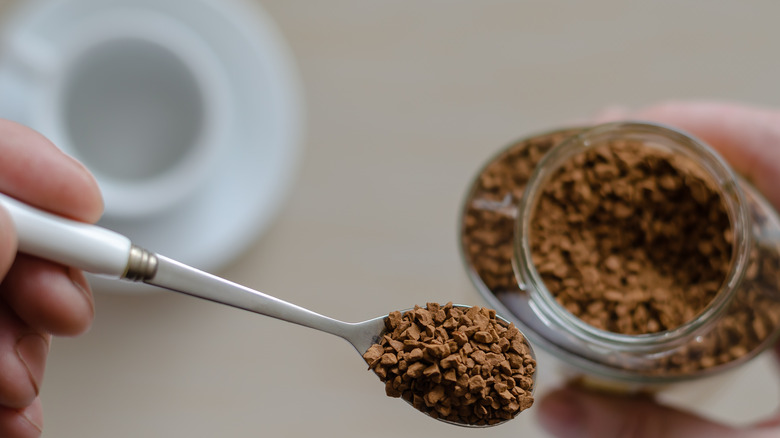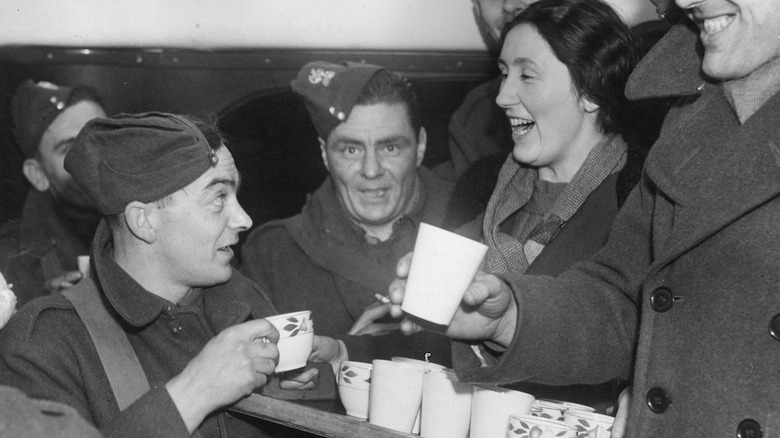The Origins Of Instant Coffee Go Way Back
If you have ever been pressed for time or found yourself somewhere short on supplies, but still wanted a caffeine fix in the morning, you might have reached for a cup of instant coffee. Rather than a cup of Joe that is made from ground coffee, which is made by extracting the flavor from the beans with hot water, instant coffee can be made by simply mixing a spoonful of dehydrated coffee — or two, depending on your strength preference — into a mug of hot water, according to Home Grounds.
Ground coffee is made, as its name suggests, simply by grinding up whole coffee beans into the desired consistency. However, while instant coffee also comes from whole coffee beans, the method of preparation is a little bit different. Instant coffee starts out the same way as ground coffee, with whole beans that are washed, roasted, ground, and brewed, according to Yahava. What sets instant coffee apart is what happens next: the brewed coffee is then dehydrated, using either a quick-drying or freeze-drying method, which forms the dehydrated coffee crystals that you will probably recognize as instant coffee. Once water is added, the crystals rehydrate, creating a fully brewed cup of coffee.
Instant coffee was invented in 1771
Its convenience makes instant coffee a great way to enjoy a hot cup of java without spending a lot of time. However, this quick-to-make beverage took hundreds of years to develop after the cultivation of coffee began. People have been drinking coffee since at least the 15th century, when the bean was grown, cultivated, and traded on the Arabian Peninsula, according to the National Coffee Association. Coffee became incredibly popular in the Middle East, where a robust coffee culture was formed. However, its origins likely date back even farther than that, to ancient Ethiopia where the bean was first discovered.
Instant coffee, however, didn't come into fruition until the 1770s, according to History of Coffee. The very first type of instant coffee was developed in Britain in 1771. Not to be outdone, America came out with its own version in 1851. However, these first versions of instant coffee, which were served in cake form, would likely not be recognizable to us today. The first soluble coffee powder, which used a process called "Dry Hot-Air" to dehydrate it, wasn't patented until 1890, by David Strang of New Zealand. The Japanese perfected this model in 1901, but an American inventor named George Constant Louis Washington was the first to bring instant coffee onto the commercial market in 1910.
Instant coffee was popular with soldiers
However, the military is really where instant coffee took off. Soldiers didn't really have a way to brew fresh coffee on the front lines, but this dehydrated coffee alternative allowed them to enjoy a cup of Joe, and get that necessary jolt of caffeine. In the Civil War, soldiers consumed instant coffee in the form of cakes, but by the time the First World War rolled around, soldiers were able to drink hot cups of water-soluble instant coffee, per I Need Coffee. By World War Two, instant coffee was a must-have for soldiers, with over one million cases of Nescafe being sent to the front lines in a single year.
These days, instant coffee is enjoyed by a variety of people, from campers who want to sip a mug of Joe outdoors, to those who simply want a quick, easy caffeine fix. However, while instant coffee has come a long way, it still probably won't win you many friends in coffee snob circles. Many people are of the opinion that instant coffee just doesn't taste as good as a fresh cup of brew. And there may be some truth to that — not only is instant coffee just not as fresh, but it is also commonly made with cheaper, more bitter Robusta coffee beans, compared to Arabica beans that are the source of most types of ground coffee, per Yahava. But if you are not too picky, instant coffee will certainly do in a pinch.


